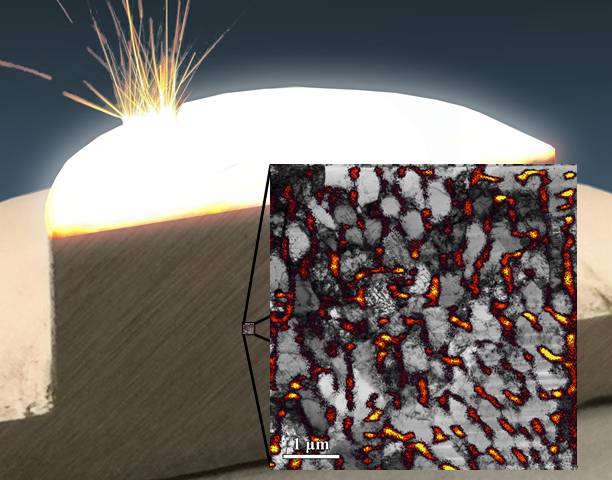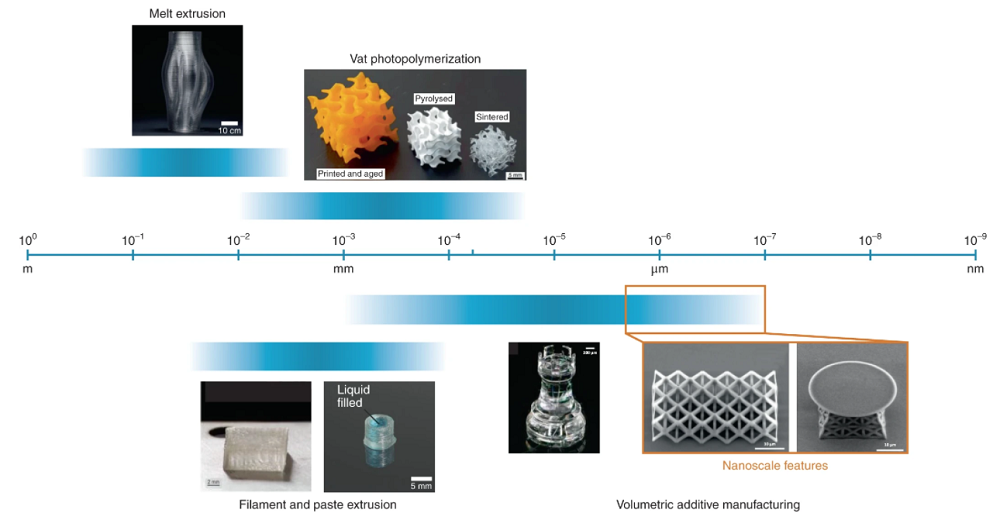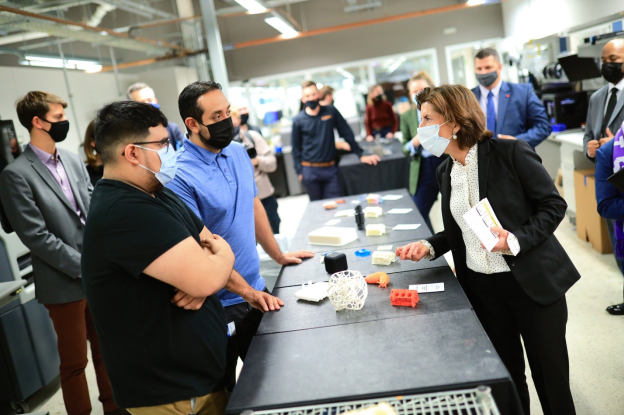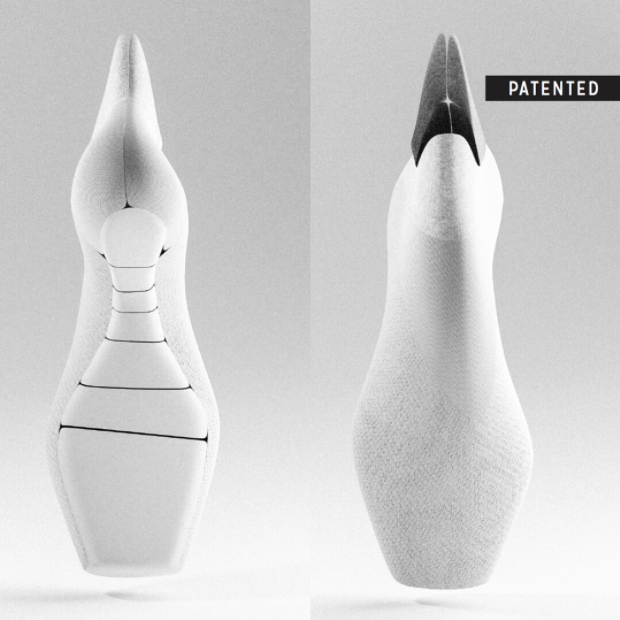In today’s 3D Printing News Briefs, we’re starting with a roundtable discussion on AM workforce development. Then we’re moving on to research, first about 3D printing a better steel, and then 3D printing glass at the nanoscale. Finally, CTI Biotech won an award for its 3D bioprinted skin model, and the winners of the purmundus Challenge were announced at Formnext 2021 last week.
AM Workforce Development Roundtable with Secretary of Commerce
The AM industry has grown up to 30% over the past five years, but it’s having trouble filling the thousands of new positions requiring technical skills. America Makes and 3D printing consulting firm 3Degrees recently led a round table discussion on additive manufacturing workforce development at technology accelerator mHub, welcoming partners who are developing training around the country, in addition to local and national government representatives, including US Secretary of Commerce Gina M. Raimondo. During the visit, everyone celebrated the completion of the pilot Advanced Manufacturing Experience (AMx) course in Chicago, an immersive AM apprenticeship program led by 3Degrees and nonprofit West Side Forward to train students between 22-50 years old on the West Side of Chicago. Several of the program participants attended the roundtable and shared their experiences, which included tours of facilities like Renishaw and Impossible Objects, in-person instruction, mentoring relationships with Siemens Energy, EOS, Desktop Metal, Met-l-Flo, Dyndrite, and Forecast3D, and taking a guided tour of RAPID + TCT.
“I’ve seen this first-hand as an entrepreneur running two companies that help large manufacturing organizations (e.g., government, aerospace, automotive) implement 3D Printing technology,” said Mike Vasquez, CEO of 3Degrees. “My clients tell me time and again that they have well-paying, benefit-eligible jobs that they cannot fill. It seems the US has forgotten how to train its workforce for today’s jobs that do not require a college degree. On the flip side, access to finding jobs in this industry is not straightforward. Most of these companies are small (<100 employees) and unless you have some network or understanding of the industry you may not know what’s happening in the white, non-descript, windowless buildings on the side of the highway.”
Researchers 3D Printing a Better Steel

A multi-modal investigation of additively manufactured 316L stainless steel revealing a heterogeneous – and correlative – distribution of crystal defects in the bright-field transmission electron micrograph (grey-scale) and alloying elements in the superimposed x-ray fluorescence map (colored). Credit: Dr. W. Streit Cunningham and Prof. Jason Trelewicz, Stony Brook University
A team of researchers from Stony Brook University published a paper about their work developing a more corrosion-resistant 316L stainless steel material, which is often used in naval applications. The study focused on the connection between corrosion behavior and the material structure in laser 3D printed 316L stainless steel, and the team used multimodal synchrotron X-ray techniques at Brookhaven’s National Synchrotron Light Source II (NSLS-II) to find new connections between print parameters and the material’s defect state; samples were printed at Penn State, and correlative electron microscopy was performed at Brookhaven’s Center for Functional Nanomaterials (CFN). These research findings could help make a more corrosion resistant stainless steel by engineering its material defects at the nanoscale.
“The major focus of our study was to understand the corrosion behavior of laser additively manufactured 316L stainless steel in the context of microstructural defects that form due to the rapid solidification rates inherent to this 3D printing process. We show that while uniform surface corrosion of the printed 316L is similar to a traditional 316L alloy, the printed material exhibits an increased susceptibility to pitting, particularly in the samples with the greatest defect density uncovered from our synchrotron measurements,” said Jason Trelewicz, PhD, corresponding author and Associate Professor of Materials Science and Engineering in the College of Engineering and Applied Sciences and the Institute for Advanced Computational Science.
3D Printing Glass at the Nanoscale

Top left, light fixture lens. Top right, a gyroid-shaped object at different stages of the vat photopolymerization process. Bottom far left, an europium-doped phosphate glass sample. Bottom second left, cup containing dyed water, highlighting high-aspect-ratio features and merged printing lines. Bottom middle, a micro-rook with a height of ∼2 mm. Bottom second right and far right, scanning electron microscopy images of an octet truss structure and a microtoroid optical resonator. Credit: top left, Liosdesign; top right, reproduced with permission from ref. 7, Springer Nature Ltd. Bottom far left, reproduced with permission from ref. 3, Elsevier; bottom second left, reproduced with permission from ref. 4, Wiley; bottom middle, reproduced with permission from ref. 8 Wiley; bottom second right and far right, reproduced with permission from ref. 9, Springer Nature Ltd.
Glass qualities are often tied to the applications in which the material is used, and 3D printing is capable of fabricating parts with a vast variety of geometries, but because higher processing temperatures are needed to form glass than plastics, it got a late start in the industry. The feature resolution for glass 3D printing is still limited to micrometers, but a pair of researchers, hailing from Penn State and the University of Padova in Italy, recently published a paper on 3D printing glass at the nanoscale, stating that they were able to print “silica glass components with a resolution below 200 nm.” The method they used for their proof of concept was based on two-photon polymerization, or 2PP, and they experimented with a “commercially available polyethylene glycol (PEG)-functionalized colloidal silica with an ~10 nm dimension.”
“By matching the PEG functional groups with those of the photocurable polymers, they enhanced the suspension miscibility, obtaining a high loading of silica nanoparticles. Furthermore, the same refractive index possessed by the two feedstock components led to high transparency and limited scattering. This enabled the 3D printing of complex structures with sub-200-nm resolution,” the researchers wrote. “The selection of the firing temperature (1,300 °C or 1,100 °C) led to the production of either crystalline or amorphous silica. The researchers went one step further and employed their approach to fabricate microtoroid whispering gallery resonators with high quality factors, as well as active photonic devices produced by doping the suspension with photoluminescent rare-earth elements.”
3D Bioprinted Immune Skin Model Publication Wins Award
Last year, cell therapy research startup CTIBiotech unveiled two bioprinted full skin model technologies for skincare applications, and the resulting research publication, developed with BASF’s Care Creations, won the prestigious Henry Maso Award at the International Federation of Societies of Cosmetic Chemists (IFSCC) 2021 conference. BASF and CTIBiotech have been working together for several years, and the 3D bioprinting methods developed at CTIBiotech will allow scientists to produce copies of predictive full skin human tissue models containing macrophages—which monitor the skin’s microenvironment for signs of tissue infection, injury, or cell stress—from the human immune system, while BASF scientists will use the technology to choose the best ingredients and bio-actives for advanced skin care applications. CTIBiotech’s 3DBioprinting Manager Maxime Lègues, who presented the original work at last year’s IFSCC Congress before it was published, will receive a scholarship to attend the 2022 IFSCC Congress to receive the award in-person.
“There is a strong need for better testing systems showing how ingredients affect or can improve sensitive or allergic skin,” said Dr Sébastien Cadau, 3D tissue engineering specialist at the BASF site in Lyon, France. “The presented 3D full-size bioprinted model of human skin that contains immune system cells is therefore a solution for rapid and reliable testing of products addressing reactive skin.”
Formnext’s 2021 purmundus Challenge
Last week, the eight gold trophy winners of the annual international purmundus Challenge 3D and 4D printing design award were announced at Formnext 2021. Sophia Lindner from act’ble GmbH, which is working with athletes to develop a new pointe shoe for ballet and contemporary dance, won first prize for the patented New Pointe Shoe Sole concept, which is said to last five times longer and reduce physical pain. Ramon Mañas with Odisei Music SL took second for the 3D printed Travel Sax, which is said to be the world’s smallest, most lightweight electronic saxophone and is already being played by 1,200 customers around the world. Jamie Cook, Henry Neilson, Theo Clarkes, Mark Brown, Jess Lewis, and George Jary from HEXR, the already award-winning 3D printed custom-fitting bicycle helmet, won third place for the helmet, which combines safety and comfort because it’s made to measure.
Five special purmundus Challenge awards were also presented at Formnext 2021:
- Special Mention, Macu4, customized forearm prosthetics
- Innovation Prize, SUTD, Washington State University, and University of Colorado Denver, bespoke 3D printed soft robots
- Public Choice Award, Roberto Trunfio, 3D printed Delijuice juicer made from processed citrus waste filament
- Altair Simulation Driven Design Award, Desktop Metal, 3D printed lightweight heat exchanger Toucan Beak solution
- Newcomer Prize, ETH Zurich, 3D printed brake caliper including function integration
Subscribe to Our Email Newsletter
Stay up-to-date on all the latest news from the 3D printing industry and receive information and offers from third party vendors.
You May Also Like
Precision at the Microscale: UK Researchers Advance Medical Devices with BMF’s 3D Printing Tech
University of Nottingham researchers are using Boston Micro Fabrication‘s (BMF) 3D printing technology to develop medical devices that improve compatibility with human tissue. Funded by a UK grant, this project...
3D Printing Webinar and Event Roundup: April 21, 2024
It’s another busy week of webinars and events, starting with Hannover Messe in Germany and continuing with Metalcasting Congress, Chinaplas, TechBlick’s Innovation Festival, and more. Stratasys continues its advanced training...
3D Printing Webinar and Event Roundup: March 17, 2024
It’s another busy week of webinars and events, including SALMED 2024 and AM Forum in Berlin. Stratasys continues its in-person training and is offering two webinars, ASTM is holding a...
3D Printed Micro Antenna is 15% Smaller and 6X Lighter
Horizon Microtechnologies has achieved success in creating a high-frequency D-Band horn antenna through micro 3D printing. However, this achievement did not rely solely on 3D printing; it involved a combination...
































